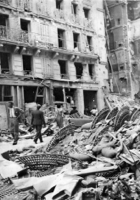
|
Very little was heard by the British Y-Service which intercepted voice traffic from three aircraft of I./SKG 10 and two of an unknown unit; and one machine from I./LG 1, one of II./KG 30 and one of I./KG 66 (this last was diverted from Lille-Vendeville to Melsbroek). Sirens sounded over Paris to warn of the approaching raid. Michel Barrat was nine years old at the time, living on the Île de la Cité: … we didn’t go down to the shelter. Some bombs fell on the Wine Market, about a kilometre upstream from us, setting fire to the wines and alcohol stored there. The sky was red and you could see by as if in broad daylight. As the neighbours said: “They’ve come back to destroy what they couldn’t carry away.” Living about 1.5 km to the east, close to the Bassin de l’Arsenal, Robert Genty, recalled: We’d scarcely reached our underground shelter when the entire building was shaken … leaving our refuge via the door on to the rue Mornay, to see what had happened … from the rue de Schomberg [about 170 m away] there came cries of pain and the noise of section of wall still crashing down … a bomb had hit a building where Republican Guards were quartered with their wives and children. Thirteen guardsmen were killed. In all, around 400 buildings, scattered right across the city, were hit with 189 dead and 890 injured. In the Marais district for example, 21 people had been killed in a six-storey building at the intersection of the rue des Francs-Bourgeois and the rue Vieille du Temple; further north, 13 more died at the Bichat Hospital; south of the Seine in the rue Monge about a dozen residential buildings were damaged or wrecked.
The Sapeurs-Pompiers (fire fighters) recorded 189 deaths in all and SHAEF’s Air Defense Review No. 3 noted that Paris’s “Fire Brigades are reported as excellent” but: No adequate civil defence organisation was evident on the night of August 26th–27th when a light raid by enemy aircraft caused considerable damage in the industrial areas in the Southwest of the city. The same document describes how the US 110th AAA Gun Battalion followed 4th Armoured Div. to the capital and had its batteries ready to fire by 2000 (GMT+2) on the 26th: At 2200 hours an attack by approximately 50 planes took place and the Battalion was able to submit 3 Category I claims.
A Ju 88 is reported by at least one source to have crashed on the forecourt of Paris’s Gobelins station. This is the kind of event which in a newly-liberated city should surely have drawn a crowd, would have been remembered and reported and quite possibly photographed (as the raid damage was). In 2014, I visited two photographic exhibitions on the city’s liberation (at the Hôtel de Ville and the Musée Carnavalet) but neither had anything about this crash and it seems at least possible that the event was the product of rumour. This may well be true also of newspaper reports that red rockets seen in the sky had been launched by enemy agents to signal the bombers (more prosaically, one observer thought them to be tracer rounds). Not unreasonably, Parisians interpreted the raid as the Germans’ revenge for their expulsion but, unless its objectives were changed at the last minute, it seems that the scattered bombing was just one more manifestation of the fast-waning proficiency of IX. Fliegerkorps. For American readers Associated Press passed quickly over the attack in the course of a wider-ranging dispatch: … the Allies have made full preparations for the air defense of Paris which was attacked Sunday night by 25–30 German JU88s but has not been raised since. The twin-engined German raiders … dropped only small caliber bombs, mostly incendiaries … and the death toll and damage would have been considerably smaller if the celebrating populace had not been caught unawares. Ob. West’s report of the 27th did not mention the bombing only that: “The situation in Paris is still not entirely clear. Numerous pockets of resistance resistance are fighting bitterly against a vastly superior enemy.” The picture that evening was the same, “based on hitherto unconfirmed reports” and Allied tanks were pushing north east from the capital toward Le Bourget. On 28 August, Model initiated court martial proceedings against the now-captive von Choltitz for failing to carry out his orders for the defence of Paris.
continued on next page …
|
|||||||||||
PART THREE OF FIVE |
||||||||||||


